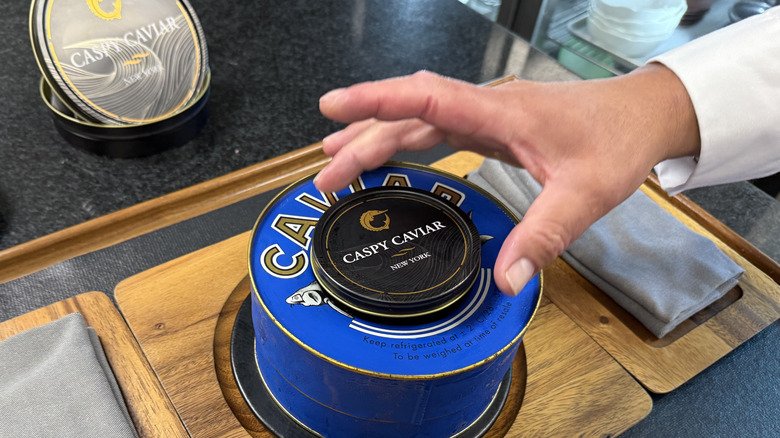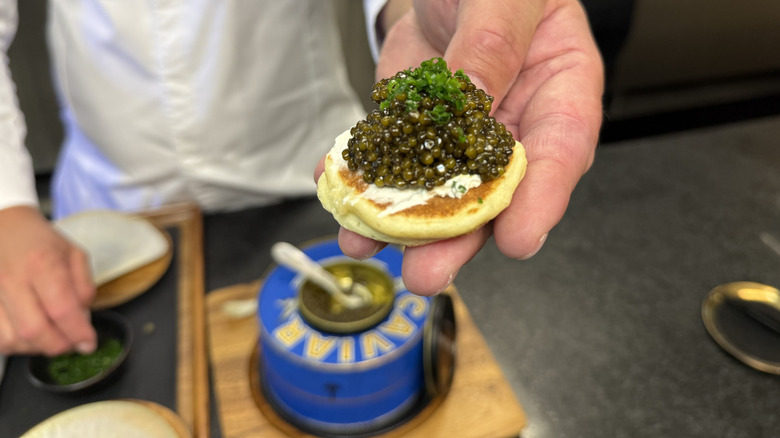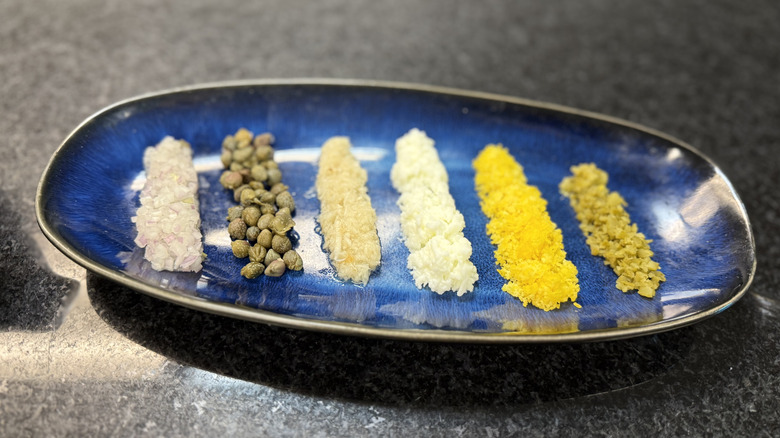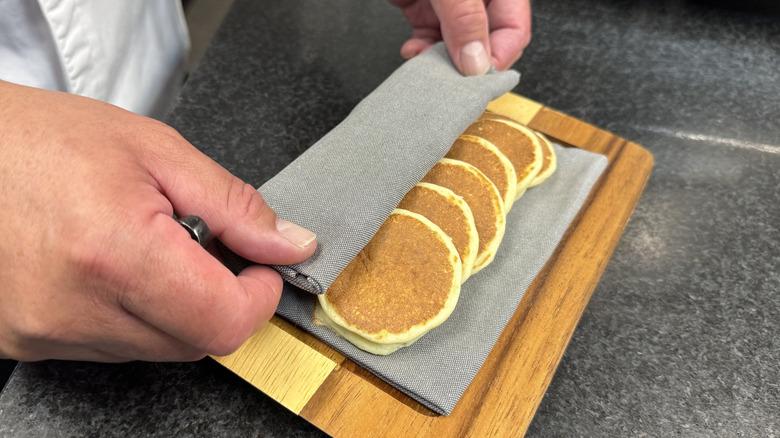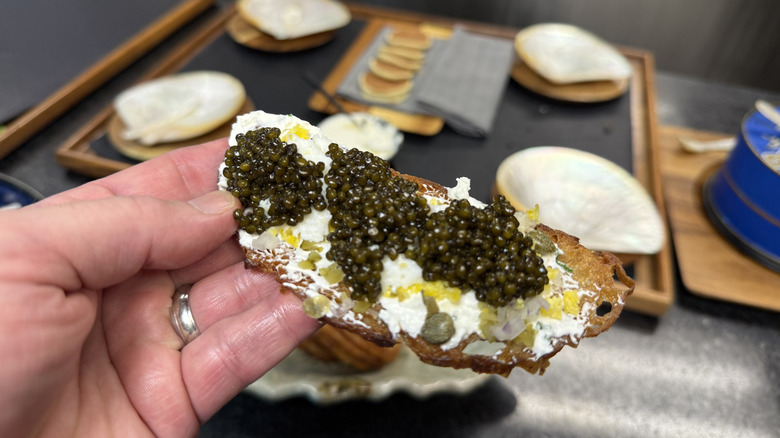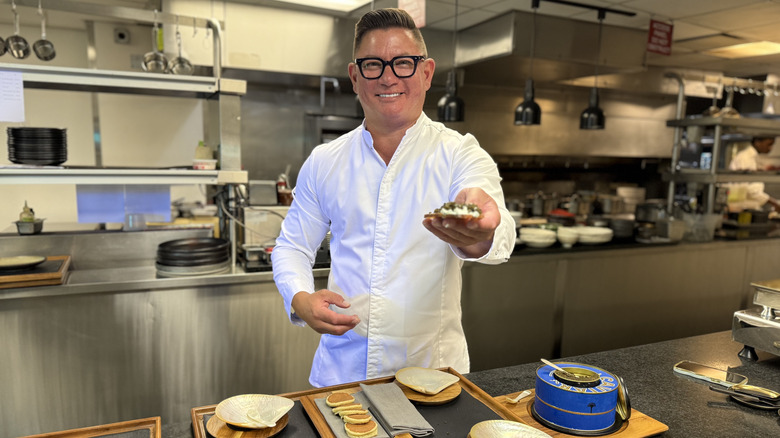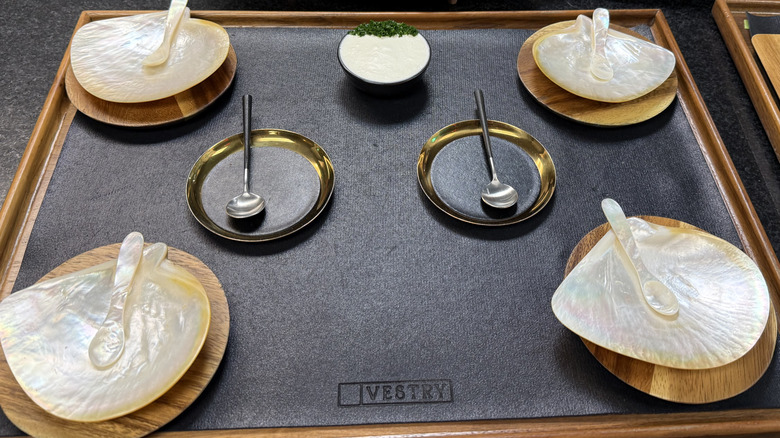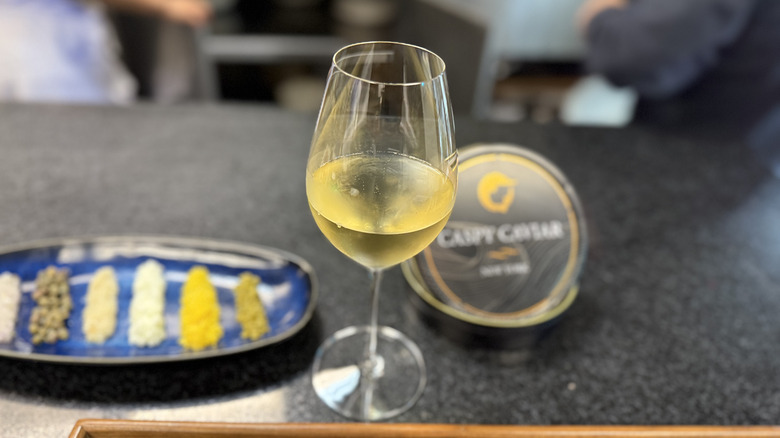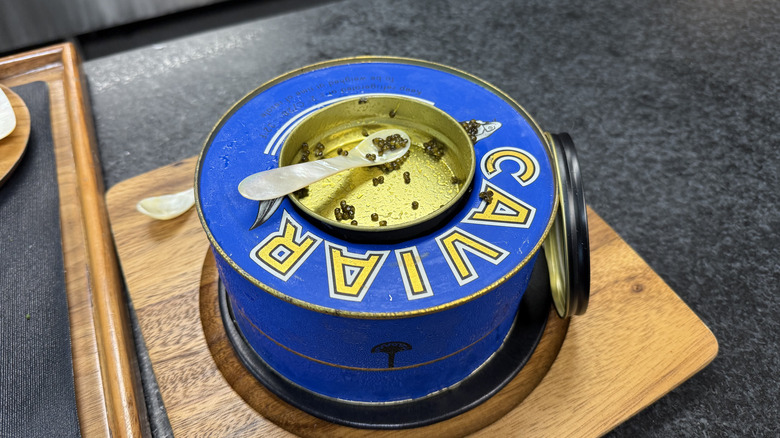How To Serve Caviar Like You Know What You're Doing
We may receive a commission on purchases made from links.
Caviar is the salted roe of large fish, namely sturgeon, and has been enjoyed as far back as the ancient Persian and Greek civilizations, and many kingdoms thereafter. Thanks to the Tsars of Russia, caviar has since been elevated as a true delicacy of the upper class. Today, caviar still maintains its cache, but has left some consumers a bit intimidated by its price tag to even bother trying it. There's one chef in particular who has been breaking the stigma and has been leading the way to make the seemingly unapproachable shiny black orbs a more accessible item for all to enjoy. Australian chef Shaun Hergatt has been serving caviar at his Michelin-starred restaurants for the past several decades, and Tasting Table has tapped into his impressive knowledge of all things caviar to show us how to serve it like you know what you're doing.
Chef Shaun's relationship with caviar started early on while growing up in a rural part of Queensland, Australia, and continued as he became a classically trained chef working through many kitchens. Chef Shaun has found much success since moving to the U.S., opening award-winning restaurants like Sho and Juni, and his current New York venture, Vestry, as well as his Las Vegas venture — Aqua Seafood Restaurant & Caviar Bar. One thing you'll always see headlined on these restaurants' menus is caviar, and these fine goods are supplied by none other than Hergatt himself, through his purveyor company Caspy Caviar. Caspy Caviar continually sources the highest quality caviar, which is ready to ship overnight to consumers and the entire restaurant industry.
Plan ahead
The first thing to keep in mind is when your event is and how many people will be attending. Chef Shaun Hergatt recommends that each guest be allotted at least 50 grams to enjoy. However, some connoisseurs, like himself, can gobble up 75-100 grams in one sitting, and he's even seen some revelers polish off 250 grams.
When I asked Hergatt which was the best caviar to buy, he didn't single out a specific type — like beluga, or kaluga, or the one perhaps perfect for beginners — osetra. Instead, he impressed upon the importance of quality sourcing, and the key is that the caviar has spent the least amount of time possible from harvesting to being packed in a tin can. He noted, "The reality of it is it [caviar] should have a firm bite to it, not too much of a pop. It should be creamy, nutty. It shouldn't taste fishy, and it shouldn't be salty. It should be quite refined in the way that it's on your palate. More importantly, it should taste fresh. I think the one thing is that if the caviar is very fresh, it's too firm. If it's too mature, it's very sticky and sloppy."
No need to buy your caviar too far in advance, as you want to keep things as fresh as possible. Don't even think about putting it in the freezer, as it will lose some of its quality once it thaws. While not many of us are going to have a special fridge like Hergatt to store our caviar in at 2 degrees Celsius (about 35.6 degrees Fahrenheit), a regular well-chilled fridge at home will do.
What part of the meal should you serve caviar?
Caviar can be incorporated into any dish, and perhaps anytime during a meal, but chef Shaun Hergatt insists there's truly only one time to serve it — right at the start. Starting with caviar sets the mood for the rest of the meal, as he calls it a "show-stopper" that greets you and your guests as you sit down at the table.
Having caviar in the middle of your meal and even later can throw off its taste, enjoyment, and even how you're pairing wines for the other dishes. Chef Shaun said, "I think I've always been a bit of a traditionalist that way. I like to add sequencing." He added, "You just enjoy the bliss of your experience. Really, it's always the start, because once you fatigue your palate, I think your senses change."
One thing to do in advance, but not too far in advance, is open your tin of caviar before it comes to the table. Whether you use the metal key that may come with your tin, or you have to rely on a butter knife, simply wedge it between the lid and the holding tin, and gently pry it open. Don't worry, it won't come flying off, but it's best to be gentle during this entire opening process. Once you've pried it open, take a moment to enjoy the beauty of the eggs all packed together, glistening in the light. Then store it back in the fridge until you're ready to serve it to your guests.
Choosing side accoutrements
When Shaun Hergatt was undergoing classic chef training, he learned the very traditional, old-world ways to serve caviar. That included serving up to 40 accouterments, which can all complement the caviar, enhance its flavor, and add additional textures to the tasting.
Chef Shaun continually pressed upon the greatness of butter or an acidulated cream as a base to use as a glue between the caviar and your serving vessel. It also works well to hold together any other accouterments you may add to the mix. If you use butter, be sure it's soft and salty. For creams, you can go with either crème fraîche or even good old sour cream, and mix in some chives or parsley for added flavor.
While the options for accoutrements are practically endless, the one that Hergatt presented worked beautifully — capers, shallots, horseradish, gherkins, egg whites, and egg yolks. For the latter two, make some hard-boiled eggs, separate the white from the yolk, and sieve them individually using a tamis to achieve a soft and fine pile. When it comes time to taste, you can either mix and match the accoutrements with the caviar, or even see how each one pairs individually with the caviar, as the taste combinations are so wondrously different.
Serve with blini
There are many handheld ways to deliver caviar to your mouth — and perhaps the most traditional one that harkens back to its Russian roots is the blini. Blini are soft and fluffy little pancakes, but don't think for a moment about dousing them with maple syrup. These pancakes serve a higher purpose, as a sort of spongy plate for caviar.
If you have your own restaurant, or a lot of disposable income, perhaps you already own or should invest in a Japanese soufflé pancake maker, also known as a dorayaki machine, like Shaun Hergatt has at the ready in Vestry's kitchen. If you don't, a simple nonstick pan and a lid are the tools you need to make homemade blini pancakes. The blinis should also be made close to when they'll be served with the caviar. They can be any size you desire, but if you're looking for multiple nibbles, perhaps make them the size of a silver dollar. Add a little butter before dropping the batter onto the pan, and to ensure they are evenly cooked and super fluffy, be sure to cover your pan.
To keep your blini warm, stack them in a line and lay them on a cloth napkin, partially covering half of them. Take each one out as needed. Apply any butter or cream first, followed by accouterment, and top it all off with the caviar. Don't be afraid to pile it on. The more the merrier certainly applies here.
Serve with bread and toast points
While blinis are all well and good, perhaps you don't have the time or want to put in the extra effort to make them. Another excellent option, and one that delivers a whole different textural experience, is bread. What kind of bread to use is a matter of preference, as slices of a nice, soft, and flaky baguette would work just fine, but for the best results, create toast points for serving.
At Vestry, blinis are the standard vessels supplied with a caviar order, but toast points can certainly be requested. The ones in chef Shaun Hergatt's kitchen are thin toasted pieces of sourdough bread. These or any kind of toast points can be made in advance, which is extremely helpful if you have other things to do to assemble your meal. The toast points also act as a much firmer base that can house any accoutrements and the cherry on top — the caviar. Chef Shaun personally likes white bread, especially Korean milk bread, toasted, with some soft, salty butter.
Other serving vessel ideas
Over the past few decades, chefs have gotten really creative in coming up with new ways to make the salty orbs of caviar shine in new ways. Fried chicken pieces and chicken nuggets have been a rising pairing trend, as well as topping off the more snack-friendly golden brown barrels of tater tots. One can even turn a ubiquitous bag of plain potato chips into a unique and bougie snack by just adding a dash of crème fraîche and caviar.
Shaun Hergatt offered up several solid vessels to steward your spoonful of caviar — fish, seafood, crustaceans, sea urchin, and fatty tuna. While he cautioned against pairing caviar with cooked meat, it actually goes nicely with raw meat such as wagyu beef. One left-of-center vessel chef Shaun recommends is french fries, be it the standard thin ones or even waffle fries. Create a creamy dip with chives and pepper to either dip into or smother over the fries themselves. Beyond the added texture and salinity, the juxtaposition of the hot potatoes meeting cold fish adds a whole new wrinkle. Chef Shaun also thinks fries can be a good entry point for beginners, suggesting that "It's a friendly way for people who are a little bit intimidated by caviar."
While most accoutrements and vessels focus on upping the savory factor, sometimes a little sweetness goes a long way. Chef Shaun has even served caviar on a cheesecake with a reduced amount of sugar, for a combination we're ready to sink our teeth into next.
Just enjoy it by the spoonful
While we've dedicated a lot of space to crusty and soft vessels and all the salty accoutrements that can make for an incredible caviar tasting, sometimes less is truly more. Chef Shaun Hergatt cautioned that using all those side pieces may ultimately end up muddying the flavor of the caviar itself. He prefers to cut out all the middlemen and just eat caviar straight out of the tin.
While a metal key or knife will help to get to the good stuff inside the tin, one should not use a metal instrument to scoop up caviar, as metal could add an unwelcome metallic taste. The ideal spoon material is mother-of-pearl, which is made of an iridescent substance that lines the inner shell of mollusks. These spoons are not only smooth operators that add no actionable fuss to the palate, but also are just a beautiful utensil, sure to add pop to your caviar table setting.
So what happens if you don't have enough mother-of-pearl spoons, or none whatsoever? Skip the spoons altogether, add a caviar bump to the web part of your hand between your thumb and forefinger, and slurp it right up. It may make your hand a bit damp, but some prices are small to pay for pure indulgence.
Proper drink pairings and ones to avoid
When it comes to drink pairings with caviar, there is one obvious answer that always bubbles up for such an occasion — Champagne. Like caviar, there is perhaps no finer way to start a meal than with a glass of Champagne, and this perfect pairing may have stemmed from when Russians fled to France after the Bolshevik Revolution, and washed down their beloved roe with some of the popular local spirits. Chef Shaun Hergatt noted that Champagne's magic works well because it has "high acid, which helps cleanse your palate so that every bite is fresh."
Vodka is another common drink pairing, especially in Eastern Europe. Chef Hergatt cautioned that if one goes that route, it is vital that the vodka, and even the glasses they are to be served in, should be stored in a freezer. Keeping the vodka at such an icy cold temperature will ensure that the taste of vodka doesn't disrupt the taste of the caviar, and serve its actual role as a cleanser.
While bourbons and whiskeys are quite popular liquors for dining, Hergatt advocates that, for the most part, one should stay clear of brown liquids when serving caviar. The same is true of beer. However, even he has been surprised from time to time. His caviar has been paired with Louis XIII Cognac, which he revealed, "actually works well together, oddly enough, because there are a lot of notes in there, like candied orange and all these different things that you wouldn't expect that would match."
What to do with leftovers
If one is making the leap and settling in for a round of caviar, in all likelihood, there won't be anything left in the tin. Even if there are a few pieces of roe somehow left behind, most will try to make the extra effort to scoop them up with their mother-of-pearl spoons.
Well, stuff happens, and sometimes you end up with some extra caviar. Perhaps people in your party didn't eat their fair share, or you overestimated how much you needed in the first place and just bought way too much. What do you do with the sensational surplus? Since caviar is all about the timing, from the buying to the plating, the same care and attention should also be applied to leftovers.
Any leftovers should be returned to the fridge. If the tin is already opened, Shaun Hergatt says the remainder left behind should be gobbled up by the next day. If the tin was never opened, some say it can live in your fridge for up to three months, but he'd never push it past one month. He added, "That doesn't mean it's a rule. It depends on how old it is. You just don't know how long it's been sitting in the store room."

